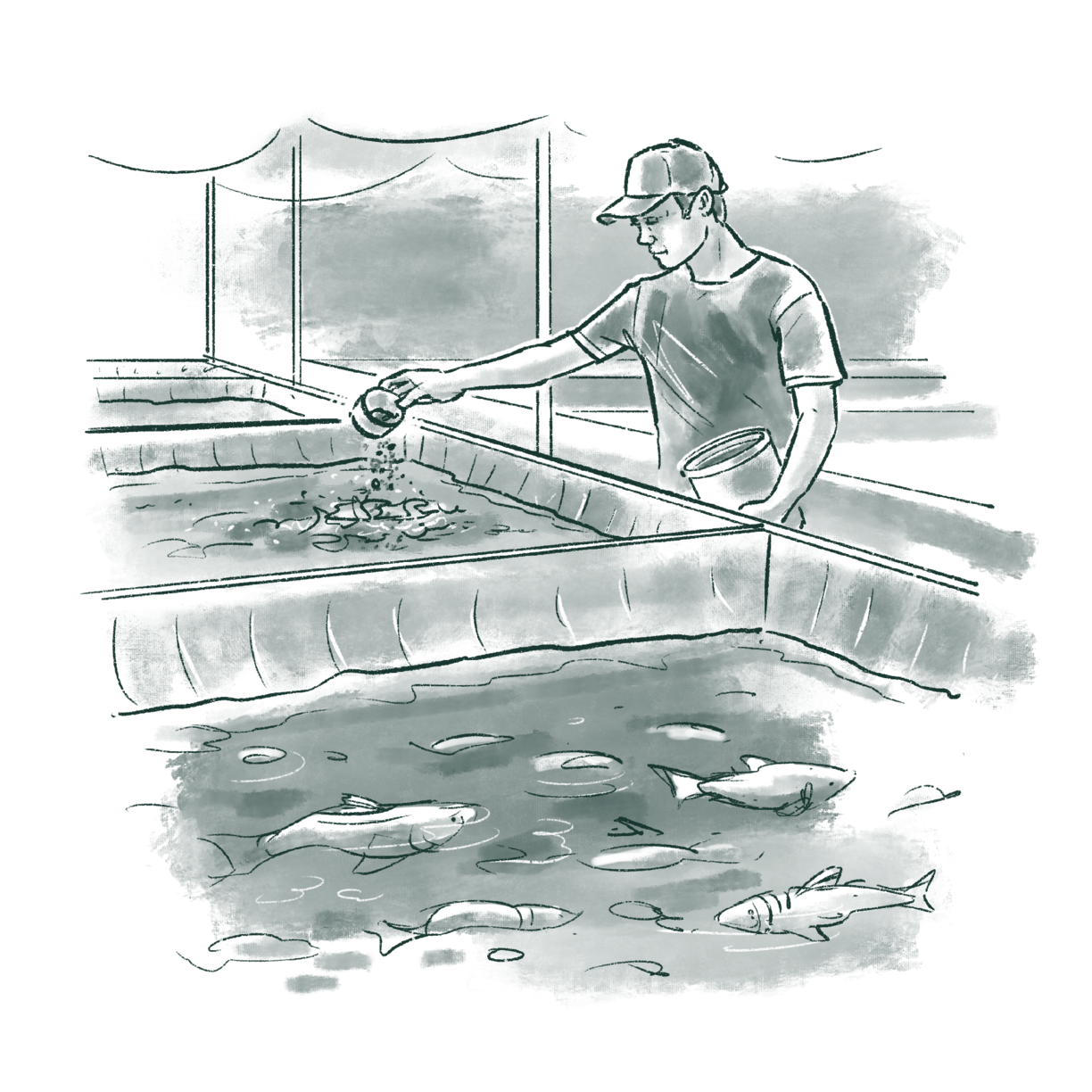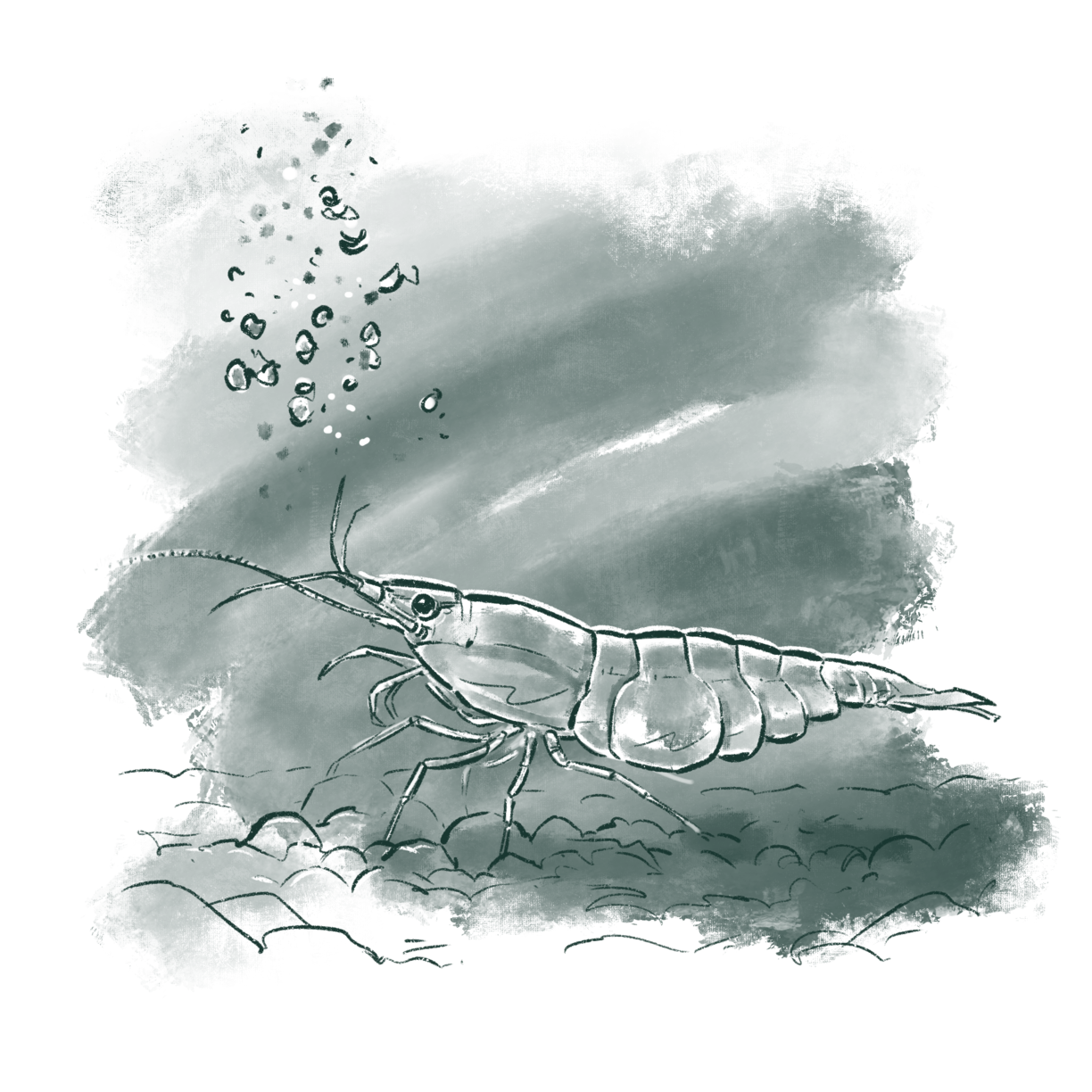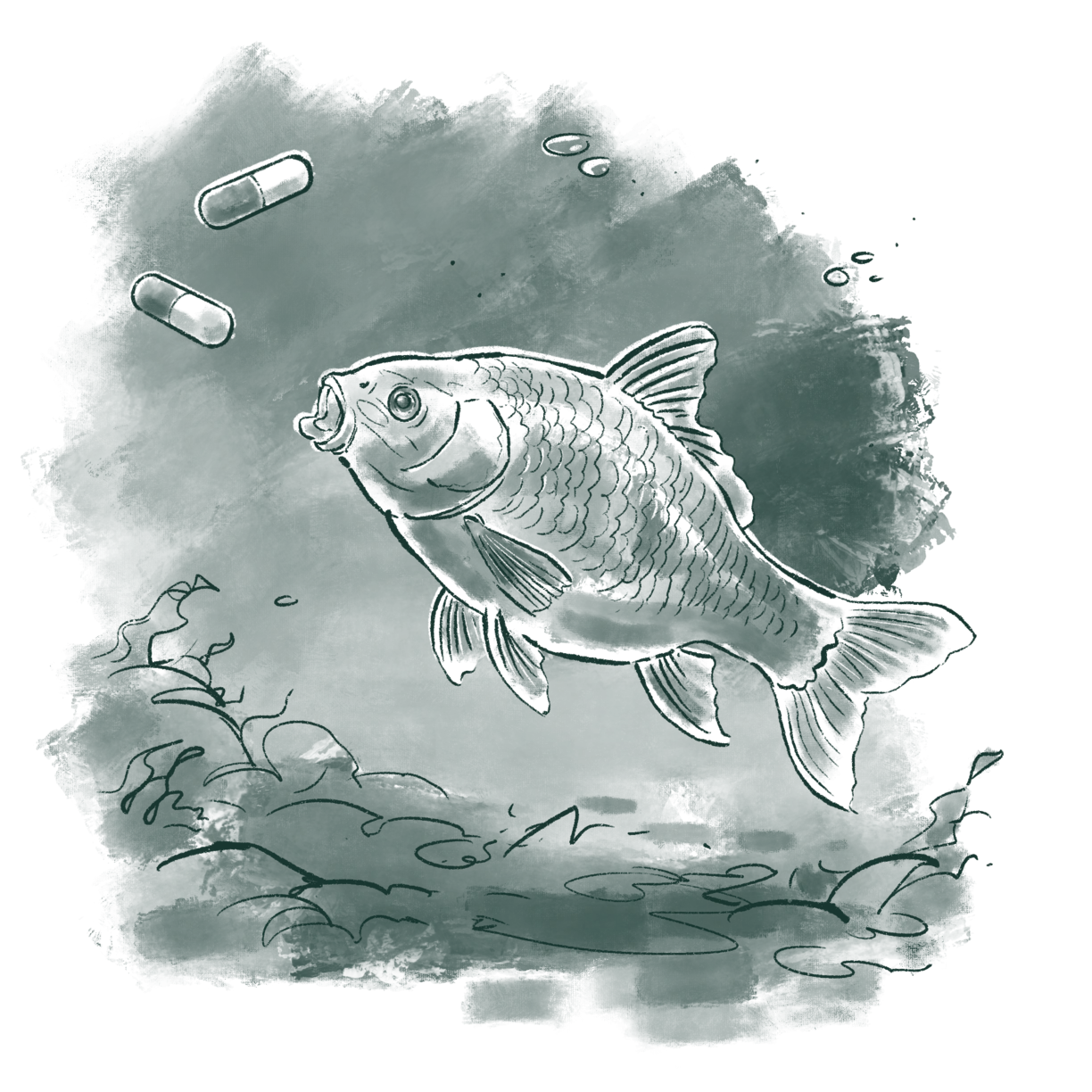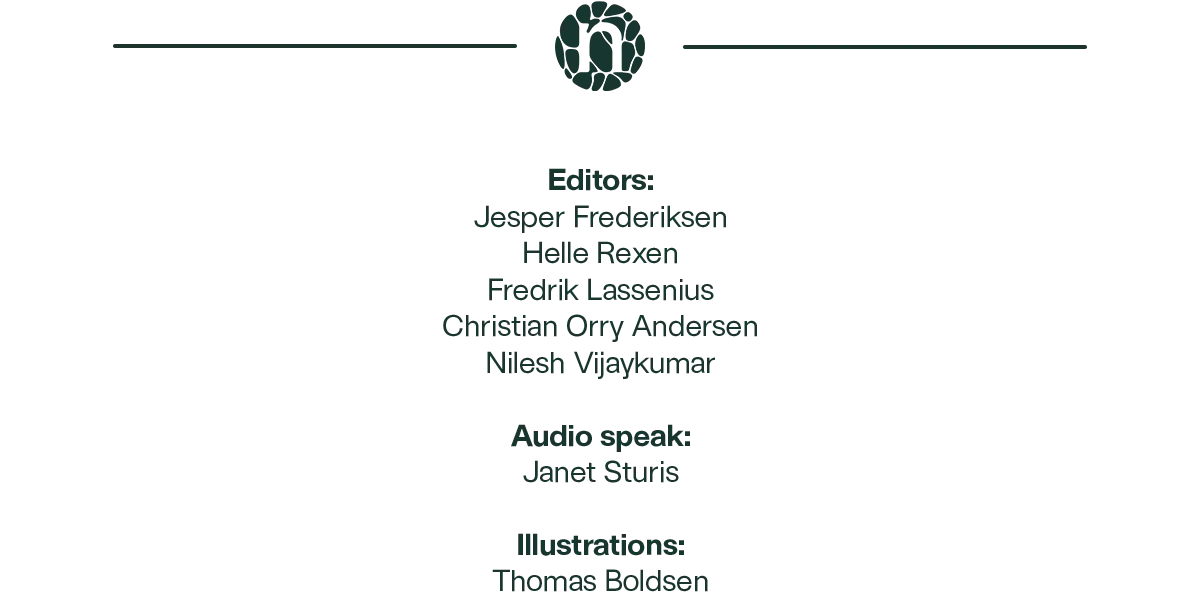Fish has been on our plates for millions of years. The earliest evidence of human ancestors eating fish dates back 1.95 million years1 in what is now Kenya. Today, fish is the most consumed animal protein globally, providing at least 20% of animal protein intake for over 3 billion people. But where does all this fish come from?
Biosolutions enhance aquaculture productivity

Unlike poultry or red meat—which mostly comes from livestock farming—over half of the fish we eat is still caught in the wild. Imagine if we relied on hunting deer and bison to feed billions of people. Forests would soon be empty. Yet, something similar is happening in our oceans, rivers, and lakes. Wild fish populations are declining, and fishers worldwide are reporting shrinking catches.
One strategy is aquaculture. It is the practice of farming aquatic food like fish and shrimp in huge aquaculture tanks located along freshwater bodies or cages in the open sea. This is not newly discovered knowledge, as the world has been gradually shifting away from wild-caught to farmed aquatic foods. In the 1990s, only 20 percent of all the aquatic food consumed in the world was sourced from aquaculture farms. This number increased to about 51 percent in 20222.
As per The State of World Fisheries and Aquaculture 2024 report by FAO, the world consumed 185 million tonnes of aquatic food in 2022, of which 94 million tonnes was from aquaculture and 91 million tonnes from the wild.
While this growth in global aquaculture can be a step in the right direction, various challenges exist that need to be addressed to make aquaculture a truly sustainable alternative to wild-caught aquatic food. This is where biosolutions play a crucial role – solutions that harness the strength of microbes like bacteria and fungi found in nature – to mitigate aquaculture’s environmental impact. In the case of aquaculture, most available biosolutions are based on bacteria.
But, before exploring what these challenges are and how bacteria-based biosolutions can help, let’s pivot a little and understand aquaculture better than just its definition.

Aquaculture, a diverse farming practice
The practice of farming fish, shrimp and oysters, etc.is more diverse than you might imagine. Around 731 species of aquatic animals are farmed around the globe, but just 17 of these species make up nearly 60 percent of global production3. It's a massive enterprise with a lot of different farming techniques, depending on what is being farmed and where it is happening.

There are two main types of aquaculture:
Inland aquaculture happens far from the coast, usually adjacent to freshwater environments like rivers, lakes, and ponds. This type of aquaculture makes up about 62.6 percent4 of global aquaculture production. Inland aquaculture farms can raise a variety of species, including carp and shrimp. However, some inland farms even use seawater to farm species that normally live in the ocean. Inland aquaculture can work in two ways:
Flow-through Systems: Imagine a giant fish tank with an unending supply of fresh water. Some farms rely on a system that pulls water from nearby rivers or lakes into the tanks, keeping the fish supplied with fresh, clean water. When the water gets too dirty, it is released back into the environment, and freshwater comes in. It sounds simple, but it can use a lot of water, and the released wastewater can impact the environment and put a strain on local freshwater resources.
Many flow-through farms have a large waste water lagoon before the release into the stream in order to capture/settle solids and other wastes that would be polluting the river. Most farms have discharge limits for eutrophication contributing components (Nitrogen and Phosphourous), but these can be challenging to manage, which is a potential area for microbial biosolutions.
- Recirculating Aquaculture Systems (RAS): Instead of constantly pumping fresh water in and discharging wastewater into the environment, RAS systems clean and reuse the wastewater. When the water starts getting dirty, it is filtered, cleaned, and reused. This system uses much less water, making it a more sustainable choice, especially for areas with limited freshwater while also providing fresh locally produced fish to inland populations that might not otherwise have access.

Marine and coastal aquaculture takes place along the coastlines, usually in large cages located in the open sea. It involves farming species that thrive in salty ocean water, like salmon, lobster, and oysters.
Now that you know how aquaculture works, let’s talk about one of the big hurdles farmers face: water contamination.
This article is part of The biosolutions bulletin. Want it in your inbox every month?
Aquaculture and water contamination
Water quality in aquaculture farms must always be maintained at its best, and that takes a lot of effort. After all, aquaculture is all about the water and the animals that live in it. If the water quality drops, animals get stressed which reduces growth and performance while making them more vulnerable to opportunistic diseases, just like when we get stressed in our everyday lives. But why does water quality deteriorate in these farms? After all, fish, and other aquatic animals live in the wild their entire lives without human intervention.

To understand this, let’s consider an analogy. Imagine you have a pet at home. What’s one of the first things you would do to keep your living space clean? You will make sure your pet does not excrete waste in the house and make a mess everywhere. With a dog or cat, it's easy enough—you can take your dog for walks or clean your cat’s litter. However, on an aquaculture farm, it's not that simple. Fish and shrimp, like all animals, excrete waste as they live and grow. But unlike pets, their waste can’t be scooped up from the bottom of their tanks.
It’s not just about waste, though. In the case of pets or livestock, farmers can easily tell if their animals are eating all their food or leaving leftovers. The leftovers can be removed easily. But in aquaculture, this isn’t as straightforward. Often, a large portion of the feed given to the fish or shrimp goes uneaten—sometimes as much as over 50 percent6.
This uneaten food then settles in the aquaculture tanks. Together with the fish waste, it deteriorates water quality. Here’s how it happens:
Ammonia Buildup and Oxygen Depletion
The waste excreted by the animals in an aquaculture tank, along with the uneaten food, is decomposed by microbes and this releases ammonia into the water. Ammonia is toxic to fish, even in small amounts. Imagine trying to breathe in a room filled with something poisonous—it’s not going to end well. But that’s not all. The microbes use oxygen available in the water to decompose the waste and uneaten food. The more waste and uneaten food there is, the more oxygen these microbes consume in the process. When the oxygen levels drop too low, fish start suffocating and die. After all, they also need oxygen to survive, just like we do. When the oxygen runs out, large numbers of fish die—and fast.
In addition to the ammonia, the decomposing waste and uneaten feed also contribute to another problem – the release of nutrients like nitrogen and phosphorus into the water. These nutrients, normally found in small amounts, act like fertilizer for phytoplankton and algae in the water. In excess, however, they fuel an overgrowth of algae, a process called eutrophication. The algae bloom so much that it can block sunlight and only the surface phytoplankton grow, while all phytoplankton underneath start to die. And as the algae die and decompose, they use up even more oxygen, worsening the conditions for the fish and other aquatic animals.
Release of Hydrogen Sulfide
When oxygen levels drop significantly in aquaculture tanks, something even more dangerous can occur: the release of hydrogen sulfide (H₂S). But how does this happen?
When oxygen levels drop in an aquaculture pond to below normal levels a group of bacteria takes over, called the Sulfate-Reducing Bacteria (SRB). They thrive in low-oxygen environments which is common in the benthic layer on the pond bottom and instead of using oxygen to break down the organic matter, they rely on sulfur to do the job. As these bacteria decompose the available organic matter in the water – the fish waste and uneaten food – one of the byproducts released as part of the process is Hydrogen sulfide (H₂S), a highly toxic gas. Even small amounts of hydrogen sulfide can be fatal to fish and other aquatic life, as it interferes with their ability to breathe. In an aquaculture setting, if hydrogen sulfide builds up, it can quickly devastate entire fish populations. This problem is particularly prevalent in shrimp farms where the salty water contributes significant amounts of sulfate.
Disease Outbreaks: A Growing Threat
Now, let's shift gears and talk about something else that has aquaculture farmers on edge: disease outbreaks.
Aquatic animals can catch all sorts of infections from parasites (like sea lice) or bacteria. In an aquaculture system, the animals live in close quarters, and when one gets sick, the disease can spread fast. When the water quality is poor, the animals’ immune systems weaken, making them more vulnerable to infections.
You might be thinking, “Can’t farmers just treat sick fish with medicine?” The short answer is yes, some antibiotics, vaccines and parasitides work. But here’s the catch: overuse of antibiotics in warm water aquaculture is leading to antibiotic resistance8. This is when bacteria evolve to become immune to the drugs that are supposed to kill them. And if these resistant bacteria spread, they could potentially make their way to humans, creating serious health risks.
In addition to bacterial infections, parasites like sea lice can be a big problem. They attach themselves to fish, causing harm, weakening the animals, and making conditions which challenge animal growth, welfare and husbandry which is devastating to farmers.
But there’s hope on the horizon. The aquaculture industry is turning to biosolutions to combat these challenges. By using biological methods, like beneficial bacteria and fungi, farmers can improve water quality, reduce disease risks, and even reduce their reliance on antibiotics.
Biosolutions in Aquaculture

Cleaning Up the Mess: Do you remember from earlier how some bacteria decompose accumulated fish waste and uneaten food in aquaculture tanks, leading to a decline in oxygen levels and causing harm to aquatic life? Well, scientists have discovered certain strains of bacteria—especially from the Bacillus family—that, when introduced into aquaculture ponds, break down the organic waste without consuming too much oxygen.
This is especially beneficial, as these bacteria don’t just consume less oxygen; they also help improve oxygen levels in the water. As they break down organic matter, they leave less waste for other bacteria that would normally consume excess oxygen. With more dissolved oxygen available, fish and shrimp can breathe easier, literally. This leads to healthier, more active animals with better growth rates, which benefits farmers economically. Studies have shown that adding beneficial bacteria to aquaculture farms helps maintain good oxygen levels and keeps ammonia concentrations at safe levels.
Battling the Threat of Hydrogen Sulfide: Then there is the production of hydrogen sulfide (gas). Fortunately, there are biosolutions for this problem too. These solutions work in two clever ways. First, certain beneficial bacteria can be added to the water and safely consume sludge to minimize the low oxygen conditions which allow hydrogen sulfide-producing microbes to thrive, effectively preventing the problem before it starts. Second, specific strains of bacteria can actually thrive on hydrogen sulfide itself! For example, Paracoccus bacteria consume the oxygen in hydrogen sulfide to gain energy and convert the toxic gas into non-toxic compounds.
These two approaches not only prevent the toxic gas from harming shrimp but also help increase shrimp yield and growth rates.

Disease outbreaks are a big challenge in aquaculture.
Combating Disease Outbreaks with Biosolutions: Disease outbreaks are a big challenge in aquaculture. This is where biosolutions, especially probiotics, come to the rescue. Probiotics are beneficial bacteria that are added to the water or mixed with fish feed. They are often available in the form of powders, liquids, or pellets, making them easy to apply in aquaculture ponds. These helpful bacteria work in several ways. First, they act as natural defenders by creating a barrier against harmful germs when fed to the host.. They also dramatically improve water quality which reduces the stress on the animal making them more healthy and less prone to opportunistic diseases.
Microbes can do this naturally by producing the right enzymes and being specifically selected and formulated to work under a wide range of aquatic conditions. But that’s not all—the right probiotics also help fish and shrimp digest their food better. They produce enzymes that break down nutrients, making it easier for animals to absorb vitamins, proteins, and fats.
Better digestion leads to healthier, stronger animals with a stronger immune system, making them less likely to get sick. Plus, probiotics improve water quality by breaking down waste and creating a cleaner, healthier environment for aquatic life.

Harnessing nature for successful aquaculture
The global shift toward aquaculture is an attempt to secure a more sustainable food future for billions of people. With the support of innovative biosolutions, the aquaculture industry is overcoming some of its toughest challenges—from water contamination to disease outbreaks—ensuring the health of aquatic life and the environment.
The potential for these natural solutions to revolutionize aquaculture is immense, making the practice more efficient, sustainable, and safer for both consumers and the planet.

Dive into the essential role of water in supporting life
Water is the source of all life, yet it’s under constant threat from pollution, overuse, and climate change. In this article we dive deep into the fascinating world of aquatic ecosystems, uncovering their significance and the challenges they face.
Read the article and learn how innovative biosolutions can help protect our waterways for future generations.
What is a biosolution?
Microbes and enzymes are tiny but mighty agents of change. For billions of years, they’ve enabled transformation in all living things through microbiology.

All you need to know about biosolutions, delivered monthly
Biosolutions are fascinating but can be difficult to grasp. That's why we created the monthly Biosolutions Bulletin — to break down the science into easy-to-understand, engaging stories with beautiful hand-drawn illustrations.
Each issue dives deep into the science behind biosolutions and their roles in transforming everything from agriculture to industries and the products we use every day.
Sign up today to stay updated!
One more step…
To complete the get in touch form or sign up, please click on the button below to enable cookies.
1. The World's First Fish Supper
2. The state of world fisheries and aquaculture 2024
3. Farmed aquatic species and diversity: The state of world fisheries and aquaculture 2024
4. Key Messages: The state of world fisheries and aquaculture 2024
5.Particulate waste outflow from fish-farming cages: How much is uneaten feed?
6. Farm level bio-economic modelling of aquatic animal disease and health interventions
7. Twenty-year trends in antimicrobial resistance from aquaculture and fisheries in Asia